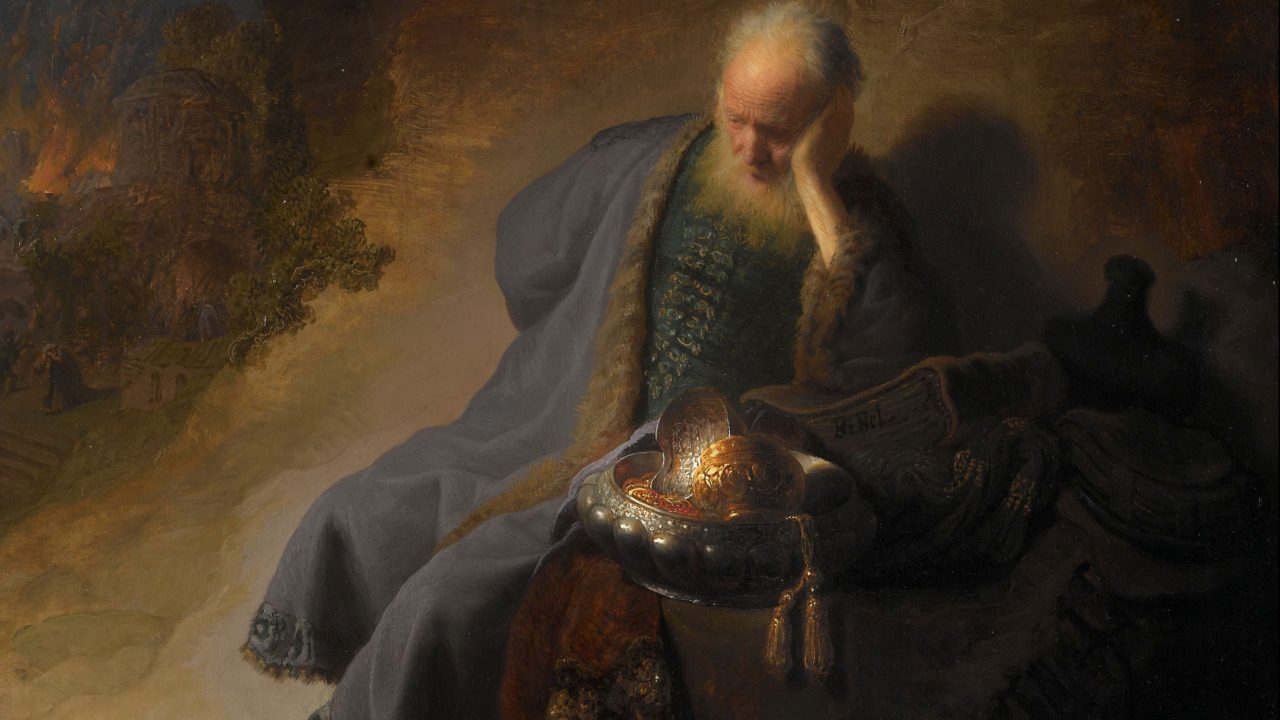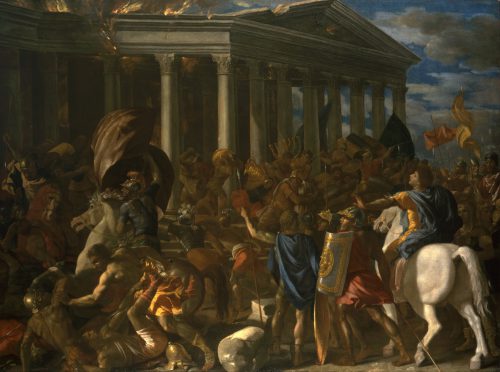How Rembrandt Understood the Destruction of Jerusalem (and Poussin Didn’t)
A tale of two paintings and one city.

This is the fifth in an occasional series of essays by Rabbi Meir Soloveichik on the intersection of Jews and Judaism with the artistic practice, and the aesthetic vision, of the great 17th-century Dutch master Rembrandt van Rijn. To see earlier installments, click here.
This is a tale of two paintings by two 17th-century masters. Both depict the same historical event. In every other respect, they present a complete contrast.
The first painting has a fascinating back story. During World War II, an eccentric Englishman by the name of Ernest Onians made a fortune with his invention of Tottenham Pudding, a form of pigswill produced from waste food. Having amassed his millions, Onians became an art collector, purchasing canvases at country fairs and garage sales and accumulating some 500 works in all. On his death in the early 1990s, his heirs consigned the whole lot to Sotheby’s, which rushed out a catalogue on the assumption that none of the paintings was especially valuable.
One image in the catalogue, depicting the destruction of an ancient city and an army bearing loot out of a building in flames, happened to catch the eye of the art historian Denis Mahon. The painting had been identified by Sotheby’s as The Sack of Carthage, a work by the minor artist Pietro Testa, and was listed at the suggested price of ₤15,000.
Looking carefully, however, Sir Denis, an expert in the art of the great French Baroque painter Nicolas Poussin (1594-1665), suspected that Sotheby’s attribution was incorrect. What may have tipped him off was that among the looted objects was a menorah—which meant that the city wasn’t Carthage after all. Or perhaps he noticed the picture’s striking similarity to a 1638 painting by Poussin titled Conquest of Jerusalem by the Emperor Titus.
Mahon’s intuition had clued him in to the greatest art discovery of the 20th century. In 1626, Poussin had created an earlier rendition of the destruction of Jerusalem and the Temple by the Roman general Titus. That work, commissioned by a nephew of the Pope, had been given as a gift to Cardinal Richelieu but then repeatedly changed hands and became lost; the later painting by Poussin was thus a second version. Now, once Sotheby’s canvas was cleaned, Mahon’s hunch was confirmed; he had identified a Poussin, The Destruction and Sack of the Temple of Jerusalem, that, lost for 300 years, was worth millions.

How had Sotheby’s experts missed what Mahon saw? The answer might lie in Poussin’s artistic choices. His Temple looks nothing like the ancient Temple in Jerusalem, but rather like a duplicate of the ancient Greek Parthenon. In addition, the main characters in the painting aren’t the Jews but the Romans. As Rabbi Jonathan Sacks noted at a celebration of the find at the National Gallery, Poussin had managed to “portray a Jewish tragedy almost without Jews.”
Ironically, the presence of the menorah, the painting’s one truly Jewish feature, underscores the point. In Rome, where he executed most of his work, Poussin had clearly become familiar with the Arch of Titus with its famous sculpted relief of the Temple’s treasures, the great menorah most prominent among them, being carried in triumph through the streets of Rome. Built by pagans but revered by Christians, the arch symbolized the destruction not only of Judea but also of Judaism, now superseded by the Church.
For this artist, a Jerusalem without Jews was thus the perfect gift for a prince of the Church, bespeaking a world in which the light of Judaism had been extinguished seemingly once and for all.
The second painting in this tale of two paintings is by the young Rembrandt van Rijn. Like the Poussin, it, too, was created in the 1620s, but there any resemblance ceases.
Rembrandt’s work centers not on a city but on a man in mourning. Clothed in the finest furs, he handles bejeweled golden goblets and bowls but seems utterly indifferent to the luxury they betoken. The source of his sadness is not immediately apparent, but in examining the canvas closely one notices, on the left side, another scene: a city in flames, marauders attempting to scale its walls, and a second man fleeing with his hands over his eyes.
As was usual with him, Rembrandt did not give a title to this painting. In the past it was thought that the scene represents the destruction of the biblical Sodom, whose wickedness “cried out unto the Lord.” According to this reading, the central figure mourning the city’s destruction is Abraham’s nephew Lot, who had chosen to reside in Sodom because of its wealth and abundance, only to lose everything. To escape the fire and brimstone, Lot is now—in the other, left-hand scene—fleeing the city, having been ordered by the two angels who rescued him not to look back as it becomes engulfed in flames. As for the men attacking the city in that scene, they would be the men of Sodom who at an earlier point in the biblical narrative assault Lot’s house, demanding that he release to them the two messengers from God.
In other words, Rembrandt in this interpretation has given us two scenes featuring the same person, Lot, at different points within the same biblical episode. But this is problematic for a number of reasons. For one thing, Rembrandt rarely, if ever, merges scenes in this manner. For another, the man covering his eyes as he flees is all alone, whereas Lot fled Sodom surrounded by his family and the escorting angels. Finally, and most conclusively, the mourning man in the center is leaning on a book, clearly identified as a Bible, and seemingly drawing support from the word of God. There is nothing in the story of Lot that corresponds to so unlikely and wildly anachronistic a possibility.
It is therefore agreed today that the city being destroyed is not Sodom but Jerusalem in the last days of the First Temple; that the marauders are the invading troops of the Babylonian king Nebuchadnezzar; and that the man in the center of the scene is the most famous of all mourners of Jerusalem: the prophet Jeremiah. It is he whose predictions of Jerusalem’s destruction were largely ignored by the residents of the doomed city, and he who authored the biblical book of Lamentations, read by Jews to this day on the fast of the Ninth of Av, which this year falls on Sunday July 22.
Rembrandt’s painting is now known as Jeremiah Lamenting the Destruction of Jerusalem and hangs in the Rijksmuseum in Amsterdam.
By a neat coincidence, the edition of the Dutch Bible used in Rembrandt’s age included a drawing of the prophet in a pose similar to that presented to us in this work, thus suggestively buttressing the current view of its subject matter. But who, then, is the man in the much smaller left-hand scene who is depicted fleeing, or staggering, with his hands over his eyes? He would be none other than the royal personage described in the book of Jeremiah itself:
So the city was besieged unto the eleventh year of King Zedekiah. And in the fourth month [Av], in the ninth day of the month, the famine was sore in the city, so that there was no bread for the people of the land. Then the city was broken up, and all the men of war fled, and went forth out of the city by night. . . . But the army of the [Babylonians] pursued after the king, and overtook Zedekiah in the plains of Jericho; and all his army was scattered from him. Then they took the king, and carried him up unto the king of Babylon. . . . And the king of Babylon slew the sons of Zedekiah before his eyes: he slew also all the princes of Judah. . . . Then he put out the eyes of Zedekiah; and the king of Babylon bound him in chains, and carried him to Babylon, and put him in prison till the day of his death. (52: 5-11)
One difficulty, however, still remains. Nowhere in the book of Jeremiah is the prophet associated with any finery, fur, gold, or goblets of any sort. Where would Rembrandt have gotten the idea of placing these objects in his possession? The answer here lies in a mythified history of the Jews composed by the Jewish-turned-Roman historian Josephus in the late-1st century CE. And how would Rembrandt have become familiar with that work? By another neat coincidence, a copy was in his own house in Amsterdam, where he lived among the Jews who had found a haven in the city after the expulsions from Spain and later Portugal.
The contents of Rembrandt’s Amsterdam house have been carefully recreated thanks to records from a low moment in the artist’s life: a foreclosure on the property and the bank’s meticulously kept account of everything the house contained. Rembrandt’s library was anything but vast, but one of the few books in his possession held the works of Josephus, in whose Antiquities of the Jews we find this story of how the Babylonians rewarded the prophet who had predicted their victory:
Now the general of the army, Nebuzaradan, when he had carried the people of the Jews into captivity, left the poor, and those that had deserted, in the country; and made one, whose name was Gedaliah the son of Ahikam, a person of a noble family, their governor. . . . He also took Jeremiah the prophet out of prison; and would have persuaded him to go along with him to Babylon. . . . But the prophet had no mind to follow him, nor to dwell anywhere else; but would gladly live in the ruins of his country, and in the miserable remains of it. When the general understood what his purpose was, he enjoined Gedaliah . . . to take all possible care of [the prophet], and to supply him with whatsoever he wanted. So when he had given him rich presents, he dismissed him.
This, then, is Jeremiah, the dominating presence in Rembrandt’s painting: a man choosing to remain in the land of his ancestors and seeking solace not in his luxurious possessions but in the biblical text on which he literally and figuratively leans. In this way, indeed, the painting can be seen as portraying not only one man at one moment in time but also the Jewish people, centuries later, having undergone the destruction of Jerusalem and of the Second Temple by the Roman legions under Titus, and all of the Jews in all of the lands of exile throughout the ensuing millennia, mourning the loss of their sacred land, yearning to return, and sustained in that hope by the word of God.
And this is the deep contrast between Poussin’s painting and Rembrandt’s. Poussin gives us Judea destroyed and Judaism destroyed. Rembrandt gives us a Judea that has been destroyed but a Judaism that remains alive. That contrast reflects the differing aesthetic attitudes of the artists themselves; it also reflects their differing faiths, one Catholic, the other Protestant, and their differing environments, one being 17th-century Rome where Jews were shut up in the ghetto, the other being the relatively open and tolerant society of the Netherlands. If Poussin’s painting is the work of an artist for whom Judaism is a dead religion, Rembrandt’s is the work of an artist who has already experienced Judaism as a living faith and who would go on to render countless aesthetic proofs of his attachment to Hebraic themes and his acutely sensitive understanding of the biblical heritage.
There is a final contrast, and a final irony. When the news of Mahon’s discovery of the Poussin was announced, the British government acted to prevent the painting from being taken out of the country. But it was too late: the Rothschild Foundation had purchased the painting and donated it to the Israel Museum, where its portrayal of the destruction of Jerusalem and of Judaism now hangs.
Neither Poussin nor Rembrandt could have predicted this grand twist of history, but the latter would have been less likely to be surprised by it. Few coincidences in the history of art better capture the miracle of the Jewish people’s endurance than the fact that Poussin’s painting of Jerusalem destroyed now hangs in the restored and vibrant Jewish capital. Rembrandt’s painting tells us how it happened.
This essay was originally published in Mosaic.
A tale of two paintings and one city.

